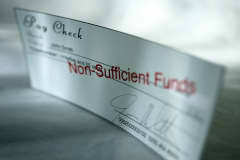
That's getting closer to the threshold that would indicate a job market not merely treading water but actually showing real growth that would take down theunemployment rate, which stands at 7.4 percent.
For most of the recovery, the jobless rate has fallen from its cycle high of 10 percent thanks largely to a shrinking labor force. The government only counts those working or actively looking for jobs in the headline rate.
Trouble is, the improvement has come on the backs of worker paychecks.
Less-publicized data Thursday showed that real weekly earnings tumbled 0.5 percent from June to July, according to the Bureau of Labor Statistics. The figure is derived from a 0.2 percent drop in real average hourly earnings, plus a 0.3 percent decrease in the average work week.
What's more, wages dropped an an annualized basis as well.
(Read more: Fed's Bullard: Inflation could return)
The BLS said average hourly earnings fell 0.1 percent from July 2012 to July 2013.
The data runs counter to some of the recent BLS monthly reports. In the July unemployment summary, which indicated the economy created 162,000 new jobs, the BLS said the annual wage gain was 1.9 percent.
Federal Reserve policy makers are watching the data closely both to see which way the jobs market is heading—and for inflationary pressures. It will be part of the central bank's decision on whether to begin pulling back on its $85 billion a month bond-purchasing program known as quantitative easing.

No comments:
Post a Comment